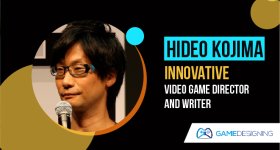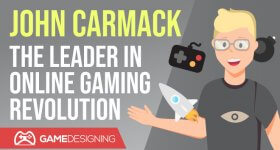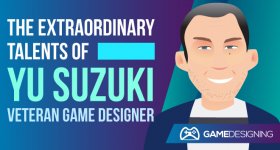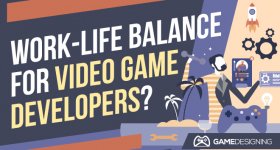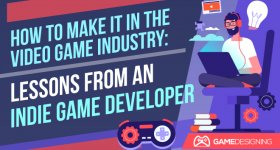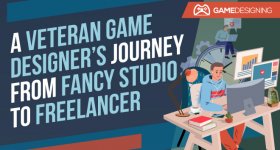In the world of video games, few people have played as large of a role in progressing video games as an art form as Hideo Kojima. For over three decades the Japanese game director has continued to release classic and critically acclaimed video games, most famously the Metal Gear series. His unique and idiosyncratic style […]
Game Design Experts Share Their Stories
Advice For Aspiring Game Designers
For a game designer, there is nothing in the world more fulfilling than completing your dream project, and releasing it to an eager public. But no one said getting there would be easy. There are many steps you’ll have to take to make it happen, and plenty of challenges you’ll face along the way. For […]
John Carmack: How He Revolutionized FPS Games With 3D Premier Graphics
If you consider yourself a serious gamer, chances are that you know the name John Carmack. Even if you aren’t familiar with the name, don’t worry about your gamer cred going down. You definitely know his games. Doom, Quake, and Return to Castle Wolfenstein have all shaken the foundations of first-person shooters, leaving an indelible […]
How Ralph Baer Changed the World of Gaming Forever
If the newest generation’s release is any indication of how popular gaming in your own home has become, it’s safe to say that gaming is permanently here to stay. Whether you prefer PlayStation 5, the new Xbox, or even playing your Nintendo Switch on your living room TV, home consoles are a huge deal. It […]
Meet Yu Suzuki, The Non-Player, Whose Always Thinking in 3D
Suzuki’s Background Born in Kamaishi, Iwate, Japan, in 1958, Yu Suzuki was in the perfect spot to join the gaming revolution. He joined up with Sega in the early 1980s and started making games. His first, a boxing game called Champion Boxing, paved the way for one of the most influential fighting games ever to […]
Nolan Bushnell, Grandfather of Video Game Systems
If you don’t recognize the name Nolan Bushnell, you definitely know his inventions. Possibly one of the most inventive game designers who ever lived (maybe rivaling only Shigeru Miyamoto), Nolan Bushnell is basically the grandfather of video game systems. Bushnell’s Roots and Rise to Prominence Born and raised in Utah, Nolan Bushnell went to Utah […]
Prolific Game Creator Yuji Naka: How He Started & Life at SEGA
If you have ever played a Sonic the Hedgehog game in your life, you already know the talented game programmer Yuji Naka’s work. However, who is this video game developing great? By the time he was in his early 20s, Yuji Naka was making a name for himself at Sega designing and programming various video […]
How Roberta Williams Transformed Adventure Games Into A Beloved Genre
You may not recognize the name Roberta Williams like you would Shigeru Miyamoto or Sid Meier. And we think that’s a huge problem. As you’ll see, Roberta Williams is one of the most important figures in adventure gaming and the evolution of video games as a whole. Let’s dig in and see what makes Roberta […]
A Glimpse into the Work Life of A Game Developer
Aaron Hunter of Austin, Texas has been making digital games for over 20 years. He played video games extensively when he was young. His fascination for games turned into curiosity about how they were made which then paved the way to a career path in game development. “I started with a language called BASIC. I […]
Lessons From An Indie Game Studio Owner
A common misconception that people have about getting into video game development is that the only skill you need to learn is to code. This couldn’t be further from the truth. “I wish I had known about the many different parts of game development. You need to try all the different aspects of game development […]
Gabe Newell: From College Dropout to Billionaire CEO
If you have spent any time playing computer games on Steam, you owe gaming tycoon Gabe Newell a debt of gratitude. I know I sure do. All of those Steam sales? Expensive games going for only a few dollars? It’s excellent, and it’s the end product of Valve and Gabe Newell’s hard work. Thanks to […]
Explore The Many Worlds of Shigeru Miyamoto
When you think of video games, what comes to mind? Sure, you probably think of a few modern examples of game protagonists. However, the chances are good that you thought of Mario, Donkey Kong, or Link. These characters and other Nintendo creations are synonymous with video games. But what creative genius hatched all those ideas […]
Hironobu Sakaguchi Embraced An Uncertain Future; Tremendous Success Follows
With the release of the excellent Final Fantasy VII Remake in 2020, gamers the world over once again experienced the magic of one of gaming’s most celebrated franchises. But where did such a wonderful and influential series begin? It wasn’t born out of a vacuum: it was due to talented game designers like Hironobu Sakaguchi. […]
Self-Learning and Standing Out in A Saturated Job Market
How far will you go to achieve your dreams? Soyhan Yazgan jumped through hoops to become a game developer. He is a Turkish national who moved to Finland in 2012 to pursue his education. “I spent many years playing video games and being fascinated with technology. I’ve always wanted to be a programmer for as […]
Surviving Freelance Game Development: The Ins and Outs of Finding Work
“As a freelance game developer, I have a flexible schedule and the freedom to choose what project to work on,” Guillaume Letaeron, a French expat living in Japan, said. He is one of the growing numbers of foreign game developers settling in the land of the rising sun, searching for opportunities to work with video […]
There’s A Time For Everything: How to Be Happy Working in the Gaming Industry
Can game developers achieve work-life balance? Game Developers work with only one goal in mind: finish a video game project. Achieving work-life balance is unheard of in a career in which crunch time is part of the job description. And though they’re not exactly shy in calling for office reform, most have embraced their fate […]
Gamer to Studio Co-Owner: A Unique Path to Success
The indie game industry is perhaps more widely known for its financial failures than its success, and yet it shows no sign of slowing down. This comes as no surprise. Developers are some of the most passionate and dedicated individuals to walk this earth. And with a multi-billion dollar gaming market to invest in, it’s […]
How A Game Designer Turned A Job Loss Into an Opportunity
For the first time in his 20-year career, Darrell finds himself in between jobs, taking on freelance work as much as he could. “It’s new territory for me as I’m very much used to being in an office with a large group of people,” says the former Lead Level Designer from Sheffield, UK. “But seeing […]
How Sid Meier, Creator of Civilization
Staying up late at night, playing video games seems pretty normal. After all, if you’re playing an addictive game, what good is sleep when you can have fun? I first experienced this phenomenon in the 1990s with a game called Civilization. Thanks to some guy named Sid Meier, I was losing a ton of sleep. […]
Famous Video Game Composers
It seems like we are a million years from when video game soundtracks were MIDI-based music motifs that merely accompanied gameplay. However, the kind of music that players experience these days is of epic scope and talent. Gone are the days when little ‘beeps’ would be your entire soundtrack. It isn’t unheard of for current […]
